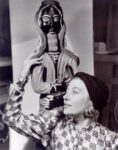
Eileen Agar
British, 1899-1991
Swanage, Dorset, 1935
watercolor on pressed board
14 3/4 x 11 3/8 in.
SBMA, London Collectors' Group Fund
1987.37.1

Eileen Agar by Lee Miller with “The Golden Tooth”, 1937
“Eileen Agar…brings the colour of dreams to everything she sees.” – Paul Eluard
RESEARCH PAPER
“Swanage, Dorset” is a collage by Eileen Agar named for the English coastal town where the artist was living at the time of its creation in 1935. Three heads of varying sizes, shown in profile, pop out from a black background as if they are reverse silhouettes. One head is a woman’s, but the gender of the other two is ambiguous. The woman’s head is the smallest of the three, and is adorned with a long black rectangle, a square-ish patch of amber, fawn-colored areas of paper, and small pieces of cellophane. The largest head repeats these shapes, colors, and materials and is positioned so the nose points slightly upward. The lips in both of these heads are pursed, giving a neutral, almost peaceful feeling.
The middle-sized head echoes the amber, black, and fawn elements of the other two and includes a circular motif made of pencil shavings. A swatch of blue-and-white gingham printed paper that has been cut and torn wraps around the neck of one of the heads. Four sepia-toned ink circles are placed in what could be considered the brain area of the head, but the heads have no eyes, ears, or hairlines – or do they? The position of some of the embellishments on all three heads mimics these facial features; heads with elements of collage were a subject often explored by Agar, and even her own head played an integral role in some of her works. In the full spirit of surrealism, she created a Ceremonial Hat for Eating Bouillabaisse, adorned with – among many other found objects – seashells and a fish bone. Agar wore the hat on a television program in 1948. In her 80s, she modeled clothing for Japanese designer Issey Miyake (Byatt), and “ … throughout her career, she had presented her body as the canvas for certain of her own works. In this sense, she was a trailblazer for the idea, now associated with Performance Art, that one's own life might constitute an ongoing process of creative expression.” (“Artists: Eileen Agar)
Agar worked in multiple media, mostly in the surrealist style. In fact, she was one of the first British women to become active in the surrealist movement. One curator has noted about another of Agar’s collages that, “She was interested in combining both geometric shapes and organic elements … in combining abstraction with surrealism.” (“‘Fish Circus’ by Eileen Agar”) Agar herself noted that surrealism “was an art movement built on freeing the human mind from overdoses of common sense.” (Agar) She also observed that “juxtaposition is one of the secrets of modern art, not transition. Collage is responsible for that, and collage is the mother of mobility.” (Ibid.)
Agar had studied in Paris, where she met the leader of the surrealist movement Andre Breton. She was married to the Hungarian writer Joseph Bard, and when the two returned to London, she began exhibiting her work. However, one should note that at the time Agar created “Swanage, Dorset,” she was having an affair with the artist Paul Nash. In fact, Nash made a collage with the title “Swanage” in 1936. Using graphite, watercolor, and his own black-and-white photographs, Nash arranged a collection of shapes that are vaguely recognizable as a human figure, an eagle, and the scabbard of a sword set on a background of a coastline. Of course, in the spirit of surrealism and its desire to explore a world beyond the obvious, the objects are actually a root with appendages that suggest arms and legs, a portion of a rock formation, and what appears to be a gnarled branch. Nash and Agar shared a fascination with the seaside at Swanage, and it is interesting to consider the connections between the artists and these two pieces with similar titles. Was Agar’s collage with three heads symbolic of her romantic tryst? Was Nash’s piece made in response to Agar’s? The two often sent each other collages through the mail, sharing artistic ideas. One can only speculate, but it is clear that this surrealistic use of collage provided Agar and other artists a way to explore the rich world of dreams, desires, and secrets.
Prepared for the Santa Barbara Museum of Art Docent Council by Andrew David Baker, 2020.
BIBLIOGRAPHY
Agar, Eileen. “Note by Eileen Agar on painting, surrealism and abstractism, and collage.” Tate Archive. https://www.tate.org.uk/art/archive/items/tga-9222-2-3-7/note-by-eileen-agar-on-painting-surrealism-and-abstractism-and-collage/2.
Anonymous. “Artists: Eileen Agar.” The Art Story, https://www.theartstory.org/artist/agar-eileen/.
Anonymous. “‘Fish Circus’ by Eileen Agar.” National Galleries of Scotland. Youtube, uploaded 12 July 2010. https://www.youtube.com/watch?v=i9vcCtEjw_E.
Byatt, A. S. “Angel of Anarchy.” The Guardian, Nov. 27, 2004. https://www.theguardian.com/artanddesign/2004/nov/27/art.asbyatt.
SBMA CURATORIAL LABELS
Agar was born in Buenos Aires the daughter of Scottish- American parentage. Her parents moved to England and she studied first with the multifaceted Slade-trained artist Leon Underwood and then at the Slade School of Art, London University. In 1928 while living in Paris with the Hungarian writer Joseph Bard, who she later married, she met most of the French Surrealists, including André Breton and Paul Eluard. She was the only woman to exhibit at the 1936 London International Surrealist Exhibition. In the mid-1930s she was very close to Paul Nash, who published the Shell Guide to Dorset in 1935, the year Agar produced this work.
British Modernism from Whistler to WWII
2016
